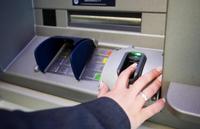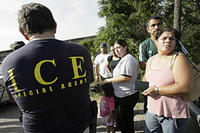-
Tightening airport ID screening loopholes
Last month a wanted murderer escaped authorities by boarding an international flight with a shoddy fake ID revealing a continuing weakness of airport security; despite being significantly older and bearing little resemblance to the man in the photo, security screeners at New York’s John F. Kennedy International Airport waived him through; TSA screeners have limited tools at their disposal to verify an individual’s documents and largely rely on a magnifying glass, a blacklight, and their eyes; critics propose implementing a biometric system to verify a passengers identity to prevent terrorists from using forged documents to enter the country
-
-
VoiceVault releases new version of its voice biometric software
VoiceVault recently announced the launch of VoiceVault Fusion, the upgraded version of its core product; VoiceVault Fusion now relies on two separate verification engines that operate symbiotically to identify an individual over the telephone, web, or on tablets and smartphones; the new version features increased accuracy, multiple verification methods, and is easier to install and integrate
-
-
States continue to fight REAL ID
The battle against the REAL ID act rages on as states continue to oppose implementing REAL ID standards; under the law states would have to remake their driver’s licenses, restructure their computer systems, and create new intra-state data sharing networks; nearly half of the states in the country have enacted anti-Real ID bills including Maine, Alaska, South Carolina, Arizona, and Oklahoma; DHS issued its third reprieve giving states an additional twenty-one months to observe the law; the National Governors Association welcomed the decision; with the recent economic downturn and many states facing budget shortfalls, many states are struggling with the costs of implementing REAL ID standards
-
-
Biometric ATMs appearing in Poland, U.S. lags far behind

More banks around the world are installing biometric ATMs that use finger vein scanning technology to authenticate a customer’s identity before they can withdraw cash; unlike current fingerprint scanners, the finger vein scanner uses infrared light to analyze the micro veins beneath the surface of the finger; banks around the world including Japan, Mexico, and Africa have begun installing these new ATMs, but they have yet to appear in the United States; critics worry that the ATMs are too invasive and a study last year found that 50 percent of Europeans would not use them; banks in the United States lack the financial incentive to install these devices
-
-
Marines integrate biometrics on battlefield
The U.S. Marine Corps is beginning to implement biometric technologies to help them identify insurgents on the battlefield; members of the III Marine Expeditionary Force in Japan are undergoing training to learn how to gather biometric data; in particular, troops are looking for fingerprints from improvised explosive devices (IEDs) to help capture bomb makers; the prints are stored in a database that will soon be shared with DHS border agents to assist with counter-terrorism efforts within the United States; border agents will be able to determine if people entering the country match any of the insurgents identified abroad
-
-
FBI upgrades fingerprint system
The FBI recently upgraded its fingerprint scanning system to include faster and more sophisticated technology; the old system could take as much as two hours to match fingerprints, while the new technology can provide results in ten to fifteen minutes; the new system is also more accurate and comes as part of the FBI’s broader technology initiative, which it calls Next Generation Identification (NGI); the next phase of NGI is set to be completed by 2014 and will incorporate latent palm prints and facial recognition technology
-
-
Biometrics technology gets below the skin
Businesses and governments around the world are increasingly turning to sophisticated iris scanning biometrics systems that are more secure than traditional fingerprint based technology; the use of iris scanners is picking up steam, despite the fact that it has not been widely adopted as mainstream biometric identification technology; India and Mexico have adopted iris scanning, while Bank of America and residential communities in Japan and Korea have also installed these scanners
-
-
Web service launched to expedite biometric ID approval process
As identifying documents like biometric passports incorporate more sophisticated technology, consumers have been forced to comply with stricter application requirements. To help consumers avoid having their photo rejected on passport and visa applications, BioID, a large European biometric company, has launched Pic4Pass.
-
-
Florida's effective DNA database
Police in Palm Bay, Florida, four years ago started a local DNA database as a quicker alternative to the state’s backlogged crime labs; the average wait to get results now is fifty-seven days, as opposed to the six- to 12-month turnaround from the Florida Department of Law Enforcement — which processes most state agencies’ samples; the kits used by Palm Bay also cost $100, compared to the $800 for DNA analysis charged by other state-approved labs
-
-
Real ID pushed back a third time
To prevent massive air travel disruptions, DHS has postponed the effective date of the Real ID Act for the third time until 15 January 2013. Real ID; DHS has met congressional and state opposition in attempting to get the Real ID Act underway; sixteen states have passed laws forbidding them to comply with Real ID, and eight states have enacted resolutions effectively boycotting it altogether
-
-
DHS to begin using portable DNA screener this summer
DHS this summer plans to begin testing a DNA analyzer that is small enough to be easily portable and fast enough to return results in less than an hour; the analyzer initially will be used to determine kinship among refugees and asylum seekers; it also could help establish whether foreigners giving children up for adoption are their parents or other relatives, and help combat child smuggling and human trafficking; eventually, the analyzer also could be used positively to identify criminals, illegal immigrants, missing persons, and mass casualty victims
-
-
California enrolls in biometric system to crack down on illegal immigration
Last week California became the ninth state in the United States to fully deploy the Secure Communities program, which automatically runs an arrested individual’s fingerprint through a national database to determine their immigration status; each year law enforcement officials arrest an estimated one million non-U.S. citizens; ICE has deported more than 62,500 aliens convicted of crimes under the program; critics of the program believe that use of the system has led to the arrest and deportation of noncriminal immigrants and are also concerned about the mandatory use of the system; a report found that in Illinois 78 percent of all detainees identified by ICE were non-criminals
-
-
Kenya orders 100,000 more biometric ID cards from OTI
On Track Innovations Ltd. (OTI) recently received an additional order for 100,000 of its MediSmart healthcare biometric ID cards; the cards were purchased by Kenya’s Smart Applications International Ltd. (SMART) for use in medical facilities across Kenya; the card contains a microchip that stores a patient’s name, picture, signature, and medical treatment records; SMART has already issued an estimated 200,000 MediSmart cards to combat fraud
-
-
Group calls for biometric component to E-Verify program

The Security Industry Association (SIA) has called for the incorporation of biometrics into the E-Verify program to prevent fraud and increase accuracy; a recent Government Accountability Office (GAO) report found that the E-Verify system was vulnerable to fraud and identity theft; a recent audit of Chipotle by ICE agents revealed that many employees are using forged documents to work in the United States; SIA recommends using biometrics to bind an individual to their identity documents, requiring biometric authentication of individuals when they apply for employments, and distributing smart cards to individuals that contain their biometric data; in 2009 nearly 8.2 million new employees were identified using the E-Verify system and this number is set to steadily grow as more states mandate employers to use the program for new hires; roughly 1,400 employers are joining the system each week
-
-
Mobile biometric screening technology for seaports years away
A recent report by the Government Accountability Office (GAO) found that U.S. Customs and Border Protection (CBP) is still years away from implementing handheld biometric screening devices electronically to verify passengers entering the United States aboard ships; approximately five million people arrive in the United States by sea each year; CBP agents currently conduct inspections aboard ships and lack access to databases to verify passports, travel documents, or passenger information and report their findings which has led to incorrect and untimely updates to national databases; DHS has made procurement of these devices a “high priority,” but believes it will be years before they can be implemented aboard ships; the primary challenge is remotely linking the mobile devices to databases in the maritime environment
-
- All
- Regional
- Water
- Biometrics
- Borders/Immig
- Business
- Cybersecurity
- Detection
- Disasters
- Government
- Infrastructure
- International
- Public health
- Public Safety
- Communication interoperabillity
- Emergency services
- Emergency medical services
- Fire
- First response
- IEDs
- Law Enforcement
- Law Enforcement Technology
- Military technology
- Nonlethal weapons
- Nuclear weapons
- Personal protection equipment
- Police
- Notification /alert systems
- Situational awareness
- Weapons systems
- Sci-Tech
- Sector Reports
- Surveillance
- Transportation
Advertising & Marketing: advertise@newswirepubs.com
Editorial: editor@newswirepubs.com
General: info@newswirepubs.com
2010-2011 © News Wire Publications, LLC News Wire Publications, LLC
220 Old Country Road | Suite 200 | Mineola | New York | 11501
Permissions and Policies
Editorial: editor@newswirepubs.com
General: info@newswirepubs.com
2010-2011 © News Wire Publications, LLC News Wire Publications, LLC
220 Old Country Road | Suite 200 | Mineola | New York | 11501
Permissions and Policies
